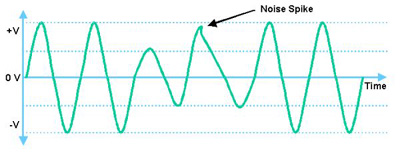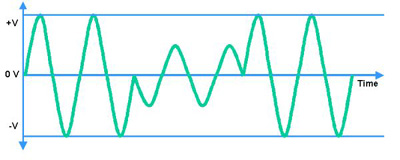

Wavespan is the first wireless IP transport company to successfully implement 256-QAM in a low-cost system. Our success in QAM modulation is due to our broad set of core competencies in digital modem and radio design, and our commitment to bring true 10 Mbps full-duplex throughput to the 5.8 GHz ISM band.
You can read about QAM technology below or you can go directly to the Bottom Line on QAM
Quadrature Amplitude Modulation (QAM) is a combination of two modulation techniques: Amplitude Modulation (AM) and Phase Modulation (PM). To explain QAM we will start with a brief explanation of AM and PM.

The
simplest schemes for AM involve the use of one amplitude to represent a binary
"0" and a second amplitude to represent a binary "1". A slightly more complicated
modulation scheme uses four amplitude levels. The first will be transmitted
to represent a binary "00" two bit combination, while a second amplitude will
be transmitted to represent the two bit combination of binary "01". In similar
fashion, the binary "10" and "11" two bit combinations are represented with
the third and fourth amplitude levels. This technique is known as di-bitting,
since two bits (a di-bit) are represented by each amplitude level change. Each
change in amplitude level is called a baud. Extending this scheme to its logical
next step, tri-bitting would involve three bit combinations and would require
8 amplitude levels (23). Quad-bitting would use four bit combinations
and would utilize 16 amplitude levels (24). In theory, it is possible
to extend this to an infinite number of bits (n), representing 2n amplitude
levels, allowing n bits/baud. While this works well in theory, in practice there
are a finite number of amplitude levels that can separately be distinguished
by a receiver. Noise spikes and fades further complicate the task of distinguishing
between discrete amplitude levels by making one amplitude level resemble another
instantaneously. ![]()

Noise can make it difficult for the receiver to distinguish the true amplitude level.
Phase Modulation can also be used to convey multiple bits of information with each change of phase, while the amplitude and frequency of the signal remain constant.

Phase Modulation varies only the phase of the signal.
In PM, each phase change equals a baud. For example, the following table is typical of di-bit modulation schemes.
| Di-bit combination | Phase Angle |
| 00 | 45° |
| 01 | 135° |
| 10 | 225° |
| 11 | 315° |
| Example of PM Modulation Di-Bit Combinations | |
Just
as in AM, it is theoretically possible to increase the number of phase angles
used in the modulation scheme to represent an ever greater number of bit combinations.
Implementation difficulties limit the practical number of modulation levels.
Noise, fade and other received signal impairments can cause one phase-angle
change to appear like another. For example if the technique involved quad-bitting,
this requires 16 (24) phase angles, separated by only 22.5°. This means that
a phase hit or noise spike that instantaneously changes the angle by as little
as 11.25° can cause the receiver to mistakenly interpret the phase angle as
a different quad-bit combination. ![]()
Quadrature Amplitude Modulation varies both the amplitude and the phase of the signal.

Quadrature Amplitude Modulation was developed to overcome the individual constraints of excessively complex AM or PM, by using a combination of the two simultaneously. By combining Phase and Amplitude Modulation at the same time, it is possible to communicate significantly more bits per baud (or symbol) transmitted over the air. A simplified example of bit/baud combinations is shown below.
| Bit combination | Amplitude Level/Phase Angle |
| 0000 | Lvl 1/ 45° |
| 0001 | Lvl 1/ 135° |
| 0010 | Lvl 1/ 225° |
| 0011 | Lvl 1/ 315° |
| 0100 | Lvl 2/ 0° |
| 0101 | Lvl 2/ 90° |
| 0110 | Lvl 2/ 180° |
| 0111 | Lvl 2/ 270° |
| 1000 | Lvl 3/ 45° |
| 1001 | Lvl 3/ 135° |
| 1010 | Lvl 3/ 225° |
| 1011 | Lvl 3/ 315° |
| 1100 | Lvl 4/ 0° |
| 1101 | Lvl 4/ 90° |
| 1110 | Lvl 4/ 180° |
| 1111 | Lvl 4/ 270° |
As you can see, QAM modulation becomes increasingly complex with every additional bit encoded per baud.
Because of the excellent Signal/Noise performance of Wavespan's 5800 receiver demodulator, up to 256 discrete amplitude/phase combinations can be decoded with accuracy. This modulation technique is known as 256-QAM. The Wavespan 5800 employs a powerful adaptive equalizer to enhance receive signal quality, and Reed Solomon Forward Error Correction, which yields an important advantage in increased receiver sensitivity and delivers a near-perfect bit error rate.
What difference does it really make if a product like the 5800 uses advanced QAM modulation? More Megabits of throughput per Megahertz (MHz) of wireless spectrum! Because 256-QAM encodes 8-bits per symbol, it is able to use the individual channels available to Frequency Hopping ISM devices very efficiently. 256-QAM enables the 5800 to deliver full 10 Mbps throughput for Ethernet TCP/IP bridge applications.